
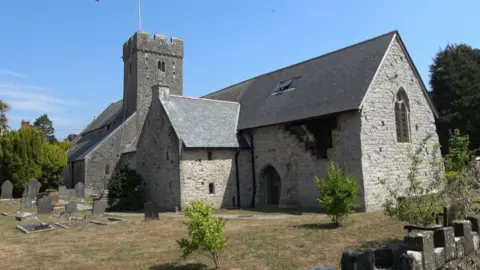 Philip Morris / Church in Wales
Philip Morris / Church in Wales
St Illtud’s Church has been in Llantwit Major since the 13th century.
An appeal has now been launched to fund restoration work at the church, which is home to Britain’s first college.
St Illtud’s Church at Llantwyth Major in the Vale of Glamorgan has been called the “cradle of Celtic Christianity”.
According to the Guinness Book of World Records, it is the “earliest center of learning in Britain” and has been home to a monastic university since around 500 AD.
Although no trace of the college now remains, the current church, named after Illud, the founder of the university, dates from the 13th century and is in urgent need of repairs.
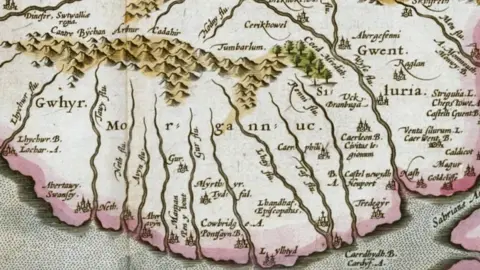 Getty Images
Getty Images
Detail of a 17th-century engraved map by the Flemish artist Jodocus Hondius showing “Llanilltud” – Llantwyth Major or Llanilltud Fawr – on the south coast of Wales.
The congregation hopes to raise £500,000 to complete the work through charitable grants and private and business donations.
The campaign will begin with an open day on Sunday 3 November, St. Illude’s Day.
Speaking at the launch of his book A History of the Celtic Christian Community in 2020, Philip Morris, former Archdeacon of Margam, said very little is known about St Illude, but the available documentary evidence points to some interesting possibilities.
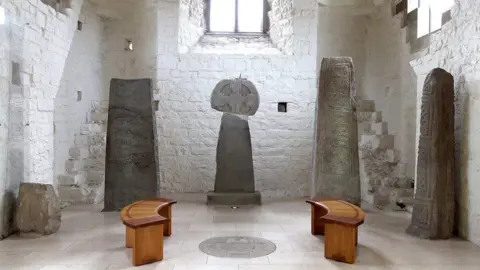 Philip Morris / Church in Wales
Philip Morris / Church in Wales
Early medieval stones in the Chapel of Galilee in the Church of St. Illude.
“Iltud is much more widely venerated in placenames and churches in Brittany than in Wales, due to the influence of his students on the development of early Christianity,” he said.
“He is described as a knight, although it is unclear how much of a fighter he was; the facts point more to his reputation as a learned man.
“In pre-Roman times, as far back as the Bronze Age, South Wales and the Bristol Channel were a key center linking the Celtic peoples of Ireland, Wales, Cornwall and Brittany with trade routes to Mediterranean Europe and the Middle East. East.”
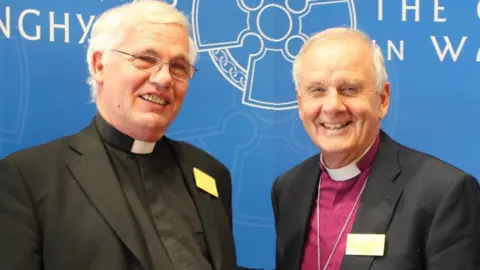 Philip Morris / Church in Wales
Philip Morris / Church in Wales
Philip Morris (left) with former Archbishop of Wales Dr Barry Morgan
Through these connections, the college has expanded to seven classrooms, 400 homes, and more than 2,000 students. Among them were the sons of both Celtic and Saxon princes, and perhaps some names still known today.
“Legend has it that people like St Patrick, St David and the bard Taliesin all studied in Llanilltude,” Mr Morris said.
“I haven’t been able to prove it one way or the other, but given that Llanilltud was a leading center of monastic learning at the time, you’d have to say it’s possible, although unlikely.”
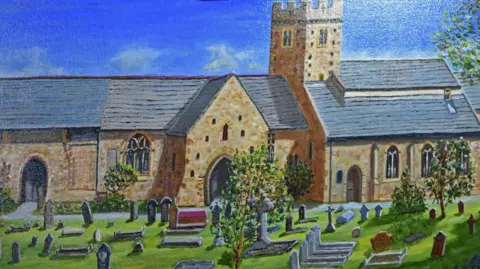 David Ellis
David Ellis
An oil painting of St Illtud’s Cathedral by church council secretary David Ellis, who is at the forefront of the fundraising campaign.
Church council secretary David Ellis said: “The church on the site of the college in St Illtud’s era was almost certainly timber and no remains have yet been found.
“However, the BBC’s Digging for Britain program, presented by Professor Alice Roberts, is conducting archaeological digs in a nearby globe field, so it will be interesting to see what their discoveries are next year.
“What we have today is actually three churches in one, all grade 1 listed. The west church is the oldest, dating from the 13th century, the east church was built around the 15th century, mainly for the monks of Tewkesbury Abbey, to whom the Normans had given the site several hundred years ago, and the latter part was built by the Galilee Chapel, built for the Raglan family only for to be destroyed by Henry VIII during the Dissolution of the Monasteries.”
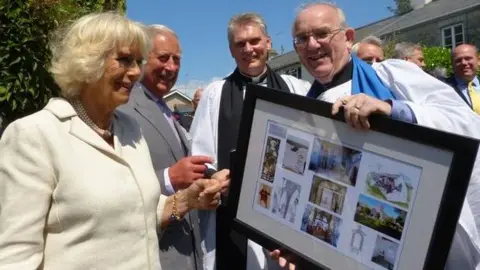 Church in Wales
Church in Wales
The Prince of Wales and the Duchess of Cornwall (now the King and Queen) study the architects’ plans during a visit to the newly opened Galilee Chapel in 2015.
The restoration of the Galilee chapel was completed in 2013 and plans were already being drawn up for the west and east churches when Covid hit.
Mr Ellis said: “The five-year delay means they have quickly fallen into disrepair and unfortunately they will now cost much more to repair than we originally expected.”
 Church in Wales
Church in Wales
St Illtud’s Church Council hopes restoration work will begin by spring 2025.
Mr Ellis believes the most serious problem is water entering the west church tower, with damage to its finial threatening its stability and jeopardizing rare examples of Norman wall paintings in the chancel below.
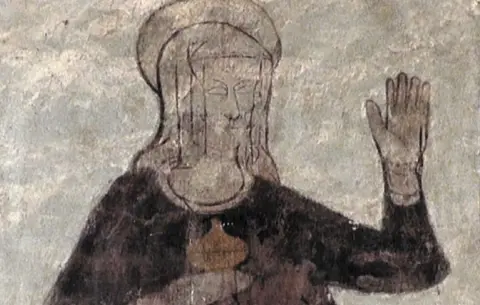 St Illud’s Church / Church in Wales
St Illud’s Church / Church in Wales
Wall painting of St. Mary Magdalene from the 13th century.
“These things take a lot of time and a lot of money, but we have to convince people of the urgency of the situation we are in now.
“Thankfully we have received a lot of positive feedback from charity groups such as the Lottery Heritage Fund and the National Churches Trust, as well as local businesses and churchgoers, so we are hopeful that there is a chance we can take things further. in the spring and carry out the most difficult repairs in good summer weather.
He hopes the fundraising will also help reinforce the values that made Llanilltud College successful 1,500 years ago.
 St Illud’s Church / Church in Wales
St Illud’s Church / Church in Wales
Children making art dressed like monks would have done this in the heyday of college.
“In Iltud’s time, the church and college were a community resource providing learning, faith, shelter and food. This is an ideal that we must continue.
“Our vicar Edwin Counsell is really keen to modernize everything, improve the lighting and make it all more accessible because we have a lot of features.
“We are a very active community center. We want everyone to know that no matter your faith or lack thereof, we are always here for you.”
